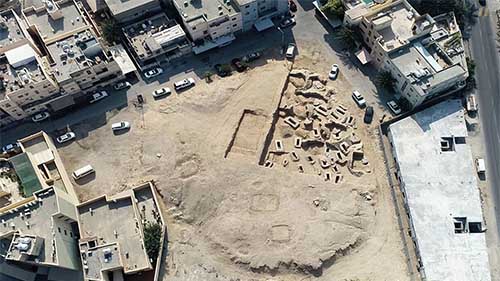07 April 2021
Bahrain Culture Authority Unveils Archaeological Discoveries by the French Expedition Team at Abu Saiba Site


The Bahrain Authority for Culture and Antiquities announced the results of the excavation work of the French Archaeological Mission at the Abu Saiba site for this year 2021, since mid-March, headed by Dr. Pierre Lombard, Head of the French Archaeological Mission and Antiquities Affairs’ Counsel at BACA.
Bahrain Culture Authority said in a statement that: “After many years of excavations at the site of the Qal'at Al-Bahrain, the French Archaeological Mission in Bahrain launched a new field project in 2017 dedicated to the Tylos burials in Bahrain (200 BC - 300 AD). This project is being implemented in close cooperation with the Bahrain Authority for Culture and Antiquities.”
The Culture Authority indicated that the site chosen for this new research program is precisely one of the Tylos cemeteries that are threatened in the short term with removal as a result of urban expansion, which is a matter that has always been a concern for the authority, the so-called site of Abu Saiba village. The “Tell” or hill (No. 1) is located in the Abu Saiba area, about 8 km west of Manama and 500 m south of Janusan roundabout on Budaiya road. Today, it appears as a small circular mound with a maximum diameter of 70 meters, and its current height is between 4 meters and 4.5 meters.
Worth to mention that this site was previously excavated for a short time by a Bahraini team in 1983, which proved the importance and richness of this hill. About 35 graves were excavated at that time, and many glazed pottery, glassware, jewelry and some tombstones were discovered, and are now on display in the Tylos Hall of the Bahrain National Museum. Indeed, since the start of the new research program launched by the French team in 2017, five seasons of excavations have been organized, with a team of five archaeologists, a specialist in bio-anthropology (to study human remains), architects and a painter.
In addition, Bahrain Culture Authority pointed out that, until this season 2021, more than a quarter of “Tell Abu Saiba” had been excavated. The excavation works sheds light on nearly 70 built graves, including three burial jars. About 40 of these graves have been fully excavated and studied, and the total area of the present site is now about 1,000 square meters.
Noteworthy also that the working period for this season was scheduled for one month, from March 15 to April 15. Due to the limitations of the COVID pandemic, the 2021 season has been curtailed and cut short, thus, organized only with a small team of (4 archaeologists). Despite these exceptional circumstances, several important results have been achieved (as of the date this news was published) - 10 new graves have been uncovered, eight are fully excavated (mainly identified in 2020, some of which are still sealed and not stolen). The following details of what was found so far in four graves on this hill are:
Tomb 43: - Locked, not stolen.
- Contains the skeleton of a child, the gender of which is not specified, ranges from 2 to 4 years old.
- Several burial items, including a colored glass perfume vial, a bronze spoon, a small beaded arm ring, and a 6-bead pendant in semi-precious stones.
Tomb 44: - Locked, not stolen.
Contains the skeleton of an elderly woman over 50 years old in good condition.
- A few burial items: one ritual bowl (outside the grave), one bead around the neck, a bronze finger ring. Could this be the grave of a servant (?)
Tomb 45: - Locked, not stolen.
Contains a child's skeleton, gender unspecified, ranging from 4 to 6 years old.
- Several burial objects, including two arm rings made of very small stone beads, a finger ring in bronze, and one necklace made of 20 semi-precious stones.
Tomb 46: - Locked, not stolen.
It contains the skeleton of a young woman between the ages of 17 and 23 years old.
- Several burial objects, including an alabaster vase with a lid, a small clay pot with a handle, a bronze earing or ear loop, and a bronze ring. Besides, two oyster shells were found near the ankle of the deceased, containing 20 spindle washers and a necklace made of 10 agate beads.
All these finds helped significantly in dating these graves to the first century AD.







